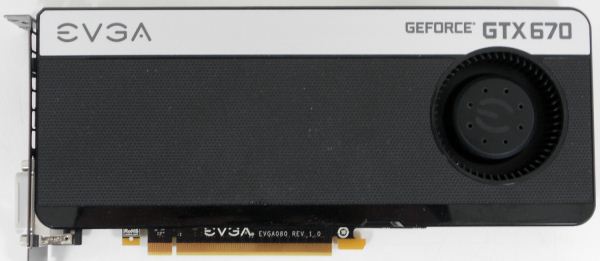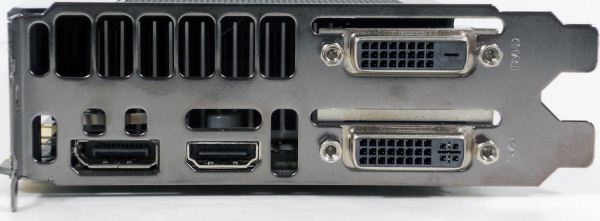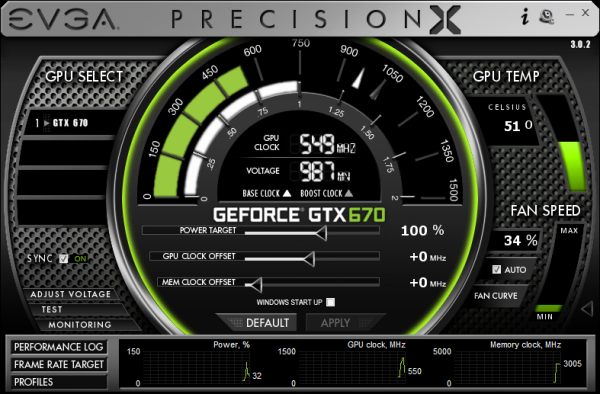NVIDIA GeForce GTX 670 Review Feat. EVGA: Bringing GK104 Down To $400
by Ryan Smith on May 10, 2012 9:00 AM ESTMeet The EVGA GeForce GTX 670 Superclocked
Our second card of the day is EVGA’s GeForce GTX 670 Superclocked, which in EVGA’s hierarchy is their first tier of factory overclocked cards. EVGA is binning GTX 670s and in turn promoting some of them to this tier, which means the GTX 670 Superclocked are equipped with generally better performing chips than the average reference card.
| GeForce GTX 670 Partner Card Specification Comparison | ||||
| EVGA GeForce GTX 670 Superclocked | GeForce GTX 670 (Ref) | |||
| CUDA Cores | 1344 | 1344 | ||
| Texture Units | 112 | 112 | ||
| ROPs | 32 | 32 | ||
| Base Clock | 967MHz | 915MHz | ||
| Boost Clock | 1046MHz | 980MHz | ||
| Memory Clock | 6210MHz | 6008MHz | ||
| Memory Bus Width | 256-bit | 256-bit | ||
| Frame Buffer | 2GB | 2GB | ||
| TDP | 170W | 170W | ||
| Manufacturing Process | TSMC 28nm | TSMC 28nm | ||
| Width | Double Slot | Double Slot | ||
| Length | 9.5" | 9.5" | ||
| Warranty | 3 Years | N/A | ||
| Price Point | $419 | $399 | ||
For the GTX 670 SC, EVGA has given both the core clock and memory clock a moderate boost. The core clock has been increased by 52MHz (6%) to 967MHz base and 66MHz (7%) boost to 1046MHz. Meanwhile the memory clock has been increased by 202MHz (3%) to 6210MHz.
Other than the clockspeed changes, the GTX 670 SC is an almost-reference card utilizing a reference PCB with a slightly modified cooler. EVGA is fabricating their own shroud, but they’ve copied NVIDIA’s reference shroud down to almost the last detail. The only functional difference is that the diameter of the fan intake is about 5mm less, otherwise the only difference is that EVGA has detailed it differently than NVIDIA and used some rounded corners in place of square corners.
The only other change you’ll notice is that EVGA is using their own high flow bracket in place of NVIDIA’s bracket. The high flow bracket cuts away as much metal as possible, maximizing the area of the vents. Though based on our power and temperature readings, this doesn’t seem to have notably impacted the GTX 670 SC.
While we’re on the matter of customized cards and factory overclocks, it’s worth reiterating NVIDIA’s position on factory overclocked cards. Reference and semi-custom cards (that is, cards using the reference PCB) must adhere to NVIDIA’s power target limits. For GTX 670 this is a 141W power target, with a maximum power target of 122% (170W). Fully custom cards with better power delivery circuitry can go higher, but not semi-custom cards. As a result the flexibility in building semi-custom cards comes down to binning. EVGA can bin better chips and use them in cards such as the Superclocked – such as our sample which can go 17 boost bins over the base clock versus 13 bins for our reference GTX 670 – but at the end of the day for stock performance they’re at the mercy of what can be accomplished within 141W/170W.
In any case, as the card is otherwise a reference GTX 670 EVGA is relying on the combination of their factory overclock, their toolset, and their strong reputation for support to carry the card. EVGA has priced the card at $419, $20 over the GTX 670 MSRP, in-line with other factory overclocked cards.
On the subject of pricing and warranties, since this is the first EVGA card we’ve reviewed since April 1st, this is a good time to go over the recent warranty changes EVGA has made.
Starting April 1st, EVGA has implemented what they’re calling their new Global Warranty Policy. Starting July 1st, 2011 (the policy is being backdated), all new EVGA cards ship with at least a 3 year warranty. And for the GTX 600 series specifically, so far EVGA has only offered models with a 3 year warranty in North America, which simplifies their product lineup.
To complement the 3 year warranty and replace the lack of longer term warranties, EVGA is now directly selling 2 and 7 year warranty extensions, for a total of 5 and 10 years respectively. So instead of buying a card with a 3 year warranty or a longer warranty, you’ll simply buy the 3 year card and then buy a warranty extension to go with it. However the extended warranty requires that the card be registered and the warranty purchased within 30 days.
The second change is that the base 3 year warranty no longer requires product registration. EVGA has other ways to entice buyers into registering, but they’ll now honor all applicable cards for 3 years regardless of the registration status. At the same time the base 3 year warranty is now a per-product warranty (e.g. a transferable warranty) rather than per-user warranty, so the base warranty will transfer to 2nd hand buyers. The extended warranties however will not.
The third change is how EVGA is actually going to handle the warranty process. First and foremost, EVGA is now allowing cards to be sent to the nearest EVGA RMA office rather than the office for the region the card was purchased from. For example a buyer moving from Europe to North America can send the card to EVGA’s North American offices rather than sending it overseas.
Finally, EVGA is now doing free cross shipping, alongside their existing Advanced RMA program. EVGA will now cross-ship replacement cards for free to buyers. The buyer meanwhile is responsible for paying to ship the faulty card back and putting up collateral on the new card until EVGA receives the old card.
There’s also one quick change to the step-up program that will impact some customers. With the move to purchasing extended warranties, the step-up program is only available to customers who either purchase an extended warranty or purchase an older generation card that comes with a lifetime warranty. Step-up is not available to cards with only the base 3 year warranty.
Moving on, along with EVGA’s new warranty EVGA is bundling the latest version of their GPU utilities, Precision X and OC Scanner X.
Precision X, as we touched upon quickly in our GTX 680 review, is the latest iteration of EVGA’s Precision overclocking & monitoring utility. It’s still based on RivaTuner and along with adding support for the GTX 600 series features (power targets, framerate caps, etc), it also introduces a new UI. Functionality wise it’s still at the top of the pack along with the similarly RivaTuner powered MSI Afterburner. Personally I’m not a fan of the new UI – circular UIs and sliders aren’t particularly easy to read – but it gets the job done.
OC Scanner X has also received a facelift and functionality upgrade of its own. Along with its basic FurMark-ish stress testing and error checking, it now also offers a basic CPU stress test and GPU benchmark.



















414 Comments
View All Comments
anubis44 - Saturday, May 12, 2012 - link
4th fastest card, eh? Have a look at these benchmarks, that actually show what the 7970 is capable of if it's OC'd to 1250MHz on the core (1870MHz memory) -- something most 7970s will do, and very few websites have been showing. To be fair, they also OC'd the GTX670 pretty much as far as it would go, too, 1330MHz on the core (1542MHz memory).http://vr-zone.com/articles/gigabyte-gtx-670-oc-wi...
At 1080p, a resolution the GTX680/GTX670 cards often do better in than 2560x1920 or higher. The 7970 wins handily on all but one benchmark (Heaven), and it's only very slightly behind on that one.
I think all AMD has to do is release 1200MHz versions of the 7970 and maybe 1050MHz versions of the 7950 and price them at about ~$400 (you can already buy 7970s for ~$450 right now) and $350 respectively. That should take quite a bit of the wind out of nVidia's sails.
CeriseCogburn - Sunday, May 13, 2012 - link
Not true.http://hwbot.org/hardware/videocard/radeon_hd_7970...
Average air OC on 7970 is 1,204 and average memory overclock is no where near 7,480 up from the stock 5,500
You've got a look at a golden sample there bub, and NO ONE is going to run that sustained clock in 24/7 gaming without some very expensive water cooling or the like and a really good warranty since burnout is likely.
CeriseCogburn - Sunday, May 13, 2012 - link
You're not going to run those overclocks on the cheapo $450 Powercolor 7970 card bub.Spin, spin spin.....
Assimilator87 - Thursday, May 10, 2012 - link
I've been rocking a 470 since it launched and there still isn't a card really worth upgrading to for F@H. 6% faster than a 580 for a supposed next gen part is abysmal. Where is REAL Kepler!?raghu78 - Thursday, May 10, 2012 - link
RyanFrom your HD 7950 review
http://www.anandtech.com/show/5476/amd-radeon-7950...
2560 X 1600 Extreme Quality 4X AA
HD 7970 - 52
HD 7950 - 47
1920 x 1080 Extreme Quality 4X AA
HD 7970 - 82
HD 7950 - 73
From your GTX 670 review
2560 X 1600 Extreme Quality 4X AA
HD 7970 - 59
HD 7950 - 47
1920 x 1080 Extreme Quality 4X AA
HD 7970 - 93
HD 7950 - 73
In the GTX 670 review the HD 7970 has improved its performance greatly while the HD 7950 has not moved a bit. This has got to be a mistake. AMD's latest 12.4 Catalyst drivers have improved 4XAA, 8XAA performance significantly. Please make the corrections.
just4U - Thursday, May 10, 2012 - link
Perhaps he doesn't have a 7950 on hand to do that with? Anyway.. I think there is alot of untapped potential with the 7X top end cards that can only be improved upon down the road with future updates to drivers.bjacobson - Thursday, May 10, 2012 - link
What happens to the boost frequencies with V-sync enabled? This could help a lot with minimums in some games.CeriseCogburn - Friday, May 11, 2012 - link
Uh... we can't test that, because amd can't do that, and amd stutters and crap with v-sync, and that would be an opressed amd card unfairly discriminated against if we did try that adaptive v-sync that ups the minimum frame rate of the nVidia card, heightens the overall frame rate, and smooths out the game. We do affirmative action here for amd.How mean are you trying to be to amd man ? No way man !
Menty - Thursday, May 10, 2012 - link
Just wanted to say thanks for including the 5870 on most of the review graphs. I've got one and it's really nice to see if the upgrade is worth it. Not that I can decide, but it's nice to have the numbers anyway! :)SlyNine - Thursday, May 10, 2012 - link
I upgraded to a 680GTX from 5870. The times that the 5870 struggled most is when this card is the biggest improvement.Cyrsis 2 when the walker shoots that bright light thing. That killed my 5870, like 5-10fps (DX 9, highest settings at release). But the 680GTX is around 30 FPS with much much higher settings. ( DX11, high res texture pack) Its def 2x the performance and more. When the performance dived on the 5870 seems to be where this card is more like 3x faster and more consistent.